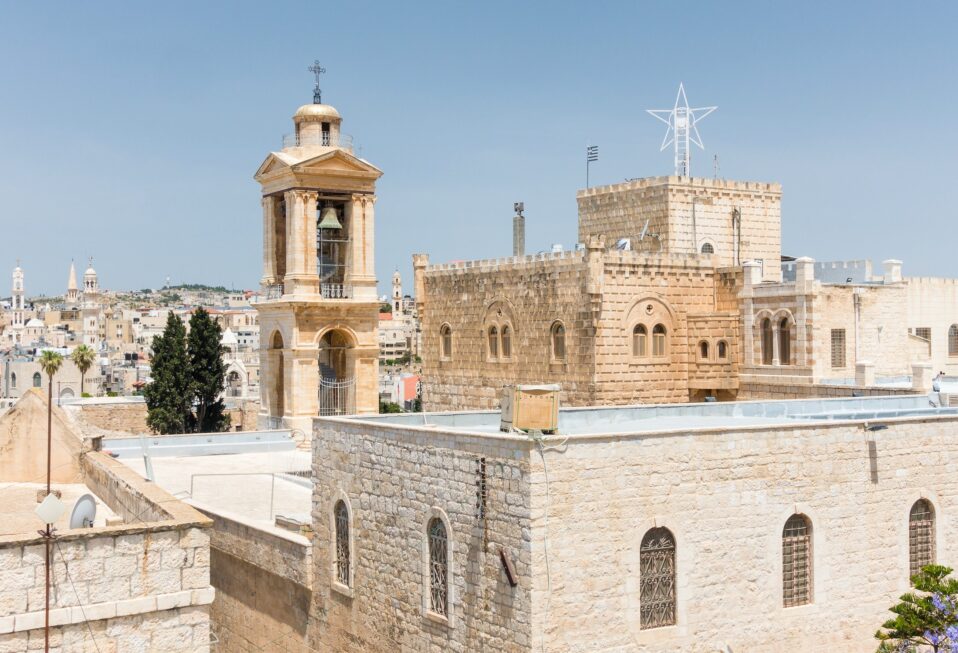By Marc Turnage
Bethlehem gains its notoriety as the birthplace of Jesus (Matthew 2:1; Luke 2:1-7); however, by the time of Jesus’ birth, the village already had quite a history. Bethlehem first appears in the Amarna Letters (14th century B.C.) as a Canaanite town. Its name comes from this period and means “house” or temple (“beth”) of Lahmu, a Canaanite deity; it did not, as is commonly assumed, mean “house of bread.” Bethlehem played an important role in the Old Testament, as it was the home of David (1 Samuel 16).
Bethlehem’s location along the central watershed route that ran north-south through the Hill Country accounts for much of its importance. Located five-and-a-half miles south of Jerusalem and thirteen-and-a-half miles north of Hebron, it served as a major juncture of roads coming from east and west that connected to the watershed route. Its strategic position and close proximity to Jerusalem led Rehoboam, king of Judah, to fortify it as part of his defenses of Judah. So, too, Herod the Great built his palace fortress Herodium to the east of Bethlehem, guarding a road that ascended to the Hill Country from En Gedi in the first century B.C.
Bethlehem sat at the eastern end of the Elah Valley (1 Samuel 17), whose western end opened onto the Coastal Plain, the land of the Philistines. Thus, when the Philistines moved into the Elah Valley (1 Samuel 17), Bethlehem was their goal, which explains the interest of Jessie and his son David in the conflict taking place in the valley. During the wars between David and the Philistines, the Philistines eventually set up a garrison at Bethlehem (2 Samuel 23:14-16; 1 Chronicles 11:16), indicating David’s struggles to control the major roadways of his kingdom.
David’s connection to Bethlehem derived, in part, from its location within the tribal territory of Judah, in which it was the northernmost settlement of Judah (Judges 19:11-12). In the fields around Bethlehem, David’s ancestors Boaz and Ruth met, and the prophet Samuel anointed David in Bethlehem, at the home of his father Jessie (1 Samuel 16).
In the first century, Bethlehem remained a small town on the southern edge of Jerusalem. The proximity of these two locations is seen in the stories of Jesus’ birth (Matthew 2 and Luke 2:1-38). Early Christian traditions, as well as the earliest Christian artwork, depict the birth of Jesus within a cave in Bethlehem. Homes in the Hill Country often incorporated natural caves into the structure. Animals could be kept within the cave, having the main living space of the family separated from the animals by a row of mangers.
Following the Bar Kochba Revolt (A.D. 132-136), the Romans expelled Jews from Bethlehem and its vicinity as part of their expulsion of Jews from Jerusalem, which was renamed Aelia Capitolina. The Emperor Hadrian built a pagan sanctuary to Adonis above the cave identified as the birthplace of Jesus. The church father Tertullian confirmed that at the end of the second century A.D. no Jews remained in Bethlehem.
In the fourth century, the Emperor Constantine—as part of his move toward Christianity—built three churches in Palestine (which is the name the Romans called the land at this time). One, the Church of Nativity, he built in Bethlehem over the traditional site of Jesus’ birthplace. Begun in A.D. 326, the church incorporated the traditional cave identified as Jesus’ birthplace into the building. St. Jerome came to Bethlehem and lived in caves around the church at the end of the fourth century to learn Hebrew from the local Jewish population, so he could translate the Old Testament from Hebrew into Latin (the Vulgate). A Samaritan revolt in 529 partially destroyed the Constantinian church. The Emperor Justinian ordered its rebuilding, which the modern Church of Nativity reflects with minor modifications.
Very little archaeological work has been done in Bethlehem. Most comes from around the Church of Nativity, but no systematic excavations have been carried out. The modern city of Bethlehem impedes the ability of much archaeological activity; thus, very little is known about Bethlehem’s archaeological past.
Marc Turnage is President/CEO of Biblical Expeditions. He is an authority on ancient Judaism and Christian origins. He has published widely for both academic and popular audiences. His most recent book, Windows into the Bible, was named by Outreach Magazine as one of its top 100 Christian living resources. Marc is a widely sought-after speaker and a gifted teacher. He has been guiding groups to the lands of the Bible—Israel, Jordan, Egypt, Turkey, Greece, and Italy—for over twenty years.
Website: WITBUniversity.com
Facebook: @witbuniversity
Podcast: Windows into the Bible Podcast




Comments(3)-

-

-





Enid Hansen says
December 21, 2022 at 3:07 am“House of Bread”. Where did that name originate? That’s the reference I’ve always heard in regard to Bethlehem, so I’m surprised it isn’t correct. (Not that I’m questioning you. I’m not.)
Slp says
December 23, 2022 at 1:26 pmThe Bible references it as place of bread or house of bread multple times.
Mary patin says
December 27, 2022 at 6:13 amI would love to visit Israel particularly Bethlehem!!
Receive Devotionals and News Updates from Israel
Recent Posts
The Palace That Could Not Stop the Messiah
Weekly Devotional: Redeemed for His Purpose
Lights in the Darkness: The Story and Hope of Hanukkah
Torah Reading Devotional: Parashat Vayeishev (וַיֵּשֶׁב) “He Settled”